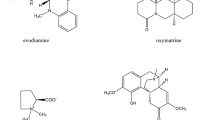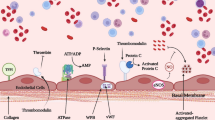Abstract
In our work evaluating the antioxidant properties of a number of cardiovascular drugs, we have emphasized the importance of lipophilicity as a property contributing to antioxidant potency. Thus, the dihydropyridine calcium channel blockers and propranolol, one of the most lipophilic beta-blockers, were found to exhibit the greatest potency in membrane and cellular models. Both beta-blockers and calcium channel blockers are classified as antihypertensive agents. We found that the specific chemical moieties of various drugs may participate in the antioxidant mechanism of action. While reviewing relevant work from the past literature, it became apparent that some of the chemical moieties of antihypertensive and vasodilator drugs may bind transition metals. Thus, this present review focuses on common properties of transition metal-interaction that are shared, to a greater or lesser degree, by a number of vasoactive drugs and chemical agents. Although this observation has been pursued by other investigators in the past, we submit that the potential relevance to the newer pharmacological agents needs to be explored further. In addition, new information regarding the role of transition metals and free radicals involving vascular cells focuses greater importance on transition metal-interaction as a potential mechanism in vasodilation. This review does not intend to be inclusive of all chemical structures capable of binding transition metals; only those that are clinically relevant will be considered in some detail. Potential mechanisms of metal-chelating actions leading to vasodilation are also discussed.
Similar content being viewed by others
References
Mak IT, Weglicki WB: Protection by beta-blocking agents against free radical-mediated sarcolemmal lipid peroxidation. Circ Res 63: 262–266, 1988
Mak IT, Arroyo CM, Weglicki WB: Inhibition of sarcolemmal carbon-centered free radical formation by propranolol. Circ Res 65: 1151–1156, 1989
Mak IT, Weglicki WB: Comparative antioxidant activities of propranolol, nifedipine, verapamil, and diltiazem against sarcolemmal membrane lipid peroxidation. Circ Res 66: 1449–1452, 1990
Weglicki WB, Mak IT, Simic MG: Mechanisms of cardiovascular drugs as antioxidants. J Mol Cell Cardiol 22: 1199–1208, 1990
Mak IT, Kramer JH, Freedman AM, Tse SYH, Weglicki WB: Oxygen free radical-mediated injury of myocytes-protection by propranolol. J Mol Cell Cardiol 22: 687–695, 1990
Kramer JH, Mak IT, Freedman AM, Weglicki WB: Propranolol reduces anoxialreoxygenation-mediated injury of adult myocytes through an anti-radical mechanism. J Mol Cell Cardiol 23: 1231–1244, 1991
Mak IT, Boehme P, Weglicki WB: Antioxidant protective effects of calcium channel blockers against free radical injury in endothelial cells: correlation with preservation of glutathione levels. Circ Res 10: 1099–1103, 1992
Mak IT, Freedman AM, Dickens BF, Weglicki WB: Protective effects of sulfhydryl-containing angiotensin converting enzyme inhibitors against free radical injury in endothelial cells. Biochem Pharmacol 40: 2169–2175, 1990
Mak IT, Weglicki WB: Membrane antiperoxidative activities of D- and L-enantiomers and dimethyl quaternary analog of propranolol. Pharmacol Res 25(1): 25–30, 1992
Freedman AM, Cassidy MM, Weglicki WB: Captopril protects against myocardial injury induced by magnesium deficiency. Hypertension 18: 142–147, 1991
Atrakchi AH, Bloom S, Dickens BF, Mak IT, Weglicki WB: Hypomagnesemia and isoproterenol cardiomyopathies: protection by probucol. Cardiovasc Pathol 1: 155–160, 1992
Schubert J: Interaction of metals with small molecules in relation to metal-protein complexes. In: FRN Gurd (ed.) Chemical Specificity in Biological Interactions. Academic Press, Inc., New York, 1954
Shroeder HA: Trace metals and chronic diseases. Adv Int Med 8: 259–303, 1956
Albert A: Selective toxicity, the physico-chemical basis of therapy. Chapman and Hall Ltd., Great Britain, 1981
Martell AE, Calvin M: Chemistry of the metal chelate compounds. Prentice-Hall, Inc., New York, 1952
Cartwright GE, Hodges RE, Gubler CJ, Mahoney JP, Daum K, Wintrobe MM, Bean WB: Studies on copper metabolism. XIII. Hepatolenticular degeneration. J Clin Inv 33: 1487–1501, 1954
Klausner RD: From receptors to genes — insights from molecular iron metabolism. Clinical Research 36 (5): 494–500, 1988
Lima MF, Kierszenbaum F: Lactoferrin effects on phagocytic cell function — II. The presence if iron is required for the lactoferrin molecule to stimulate intracellular killing by macrophages but not to enhance the uptake of particles and microorganisms. J Immunol 139: 1647–1651, 1987
Lederman HM, Cohen A, Lee JWW, Freedman MH, Gelfand EW: Deferoxamine: a reversible S-phase inhibitor of human lymphocyte proliferation. Blood 64 (3): 748–753, 1984
Cymerman-Craig J, Rubbo SD, Willis D, Edgar J: Mode of action of isonicotinic hydrazide. Nature 176: 34–35, 1955
Winder FG: Catalase and peroxidase in mycobacteria: possible relationship to the mode of action of isoniazide. Rev Resp Dis 81: 68–78, 1960
Winder FG, Denneny JM: Metal-catalyzed auto-oxidation of isoniazid. Biochem J 73: 500–507, 1959
Fallab S, Erlenmeyer H: Metal ion complexing reactions and biological activity. Helv Chim Acta XL: 363–368, 1957
Albert A, Rubbo SD, Goldacre RJ, Balfour BG: Influence of chemical constitution on antibacterial activity; study of 8-hydroxyquinoline (oxine) and related compounds. Brit J Exper Path 28: 69–87, 1947
Balla G, Vercellotti GM, Eaton JW, Jacobs HS: Iron loading of endothelial cells augments oxidant damage. J Lab Clin Med 116: 546–554, 1990
Schroeder HA, Menhard EM, Perry HM: Antihypertensive effects of metal binding agents. J Lab Clinical Medicine 46: 416–422, 1955
Sinha BK, Motten AG: Oxidative metabolism of hydralazine. Evidence for nitrogen centered radicals formation. Biochem Biophys Res Commun 105 (3): 1044–1051, 1982
Al-Falahi A, May PM, Roe AM, Slater RA, Trott WJ, Williams DR: Metal binding by pharmaceuticals. Part 4. A comparative investigation of the interaction of metal ions with hydralazine, prizidilol and related compounds. Agents and Actions 14 (1): 113–120, 1984
Jay D, Cuellar A, Zamorano R, Munoz E, Gleason R: Captopril does not scavenge superoxide: captopril prevents O2 production by chelating copper. Arch Biochem Biophys 290: 463–467, 1991
Mak IT, Kramer JH, Weglicki WB: Potentiation of free radical induced peroxidative injury to sarcolemmal membranes by lipid amphiphiles. J Biol Chemistry 261: 1153–1157, 1986
MacKellar WC, Crane FL: Iron and copper in plasma membranes. J Bioenerg Biomem 14 (4): 241–247, 1982
Heast CW, Kamp D, Duticke B: Topology of the membrane SH-groups in the human erythrocyte. Biochem Biophys Acta 640: 748–756, 1981
Quast U, Cook NS: Moving together: K+ channel openers and ATP-sensitive K+ channels. Trends in Physiol Sci 10: 431–435, 1989
Nichols CG, Lederer WJ: Adenosine triphosphate-sensitive potassium channels in the cardiovascular system. Am J Physiol 261: H1675-H1686, 1991
Ignarro LJ: Biological actions and properties of endotheliumderived nitric oxide formed and released from artery and vein. Cite Res 65: 1–21, 1989
Vanhoutte PM: The endothelium: modulator of vascular smooth muscle tone. N Eng J Med 319: 512–513, 1988
Moncada S, Radomski MW, Palmer RIM: EDRF: identification as nitric oxide and role in the control of vascular tone and platelet function. Biochem Pharm 37: 2495–2501, 1988
Ignarro LJ, Wood KS, Wolin MS: Activation of purified soluble guanylate cyclase by protoporphyrin IX. Proc Natl Acad Sci USA 79: 2870–2873, 1982
Ignarro LJ, Adams JB, Horwitz PM, Wood KS: Activation of soluble guanylate cyclase by NO-hemoproteins involves NO-heme exchange: Comparison of heme-containing and heme-deficient enzyme forms. J Biol Chem 261: 4997–5002, 1986
Gerzen R, Boehme E, Hofmann F, Schultz G: Soluble guanylate cyclase purified from bovine lung contains heme and copper. FEBS Lett 132: 71–74, 1981
Bates JN, Baker MT, Guerra R, Harrison DG: Nitric oxide generation from nitroprusside by vascular tissue. Biochem Pharmacol 42: 5157–5165, 1991
Proctor PH: Endothelium-derived relaxing factor and minoxidil. Arch Dermatol 125: 1146–1147, 1989
Author information
Authors and Affiliations
Rights and permissions
About this article
Cite this article
Weglicki, W.B., Mak, I.T. Antioxidant drug mechanisms: transition metal-binding and vasodilation. Mol Cell Biochem 116, 105–111 (1992). https://doi.org/10.1007/BF00299389
Received:
Accepted:
Issue Date:
DOI: https://doi.org/10.1007/BF00299389




